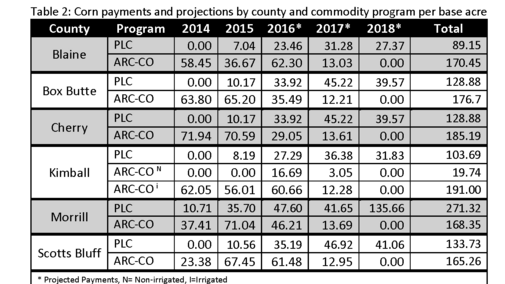This Panhandle Perspectives column, published by the University of Nebraska-Lincoln Panhandle Research and Extension Center in Scottsbluff, offers data and examples specific to western Nebraska.
The 2014 Farm Bill reached its halfway point last year, and Congress is beginning to think about a 2018 Farm Bill. Based on past and projected supports from 2014-18, some farmers may wonder whether they selected the right Farm Bill commodity program.
The answer to this question depends on the commodity and on what kind of protection was desired when enrolling acres.
The 2014 Commodity Program had two options for enrollment: Price Loss Coverage or Agricultural Risk Coverage (available at the county or individual level). These programs provided different types of protection: PLC offered long term protection from price shortfalls and ARC-CO short-term protection from downward shocks in prices and yields. This article will compare the protection of the Panhandle’s two major program crops, corn and wheat, under the two programs for counties where data are available.
Those who enrolled acres in the Price Loss Coverage (PLC) program selected long-term protection against low prices. The program was designed to protect against crop prices falling below a set level, called a reference price. PLC payments are the difference between the reference price and the national marketing year average price or the loan rate, whichever is higher. Payments are based on updated individual farm PLC yields and made on 85% of base acres. The set reference price for corn is $3.70 per bushel, and wheat is $5.50 per bushel.
Those who enrolled acres in the Agricultural Risk Coverage (ARC-CO, county level) program selected revenue protection below a moving-average guarantee, providing support early in periods of declining prices or long-term yield shortfalls. ARC-CO is a revenue-based program designed to adjust to major declines in price or yield.
Payments are made when the average county revenue for a covered commodity is less than the guarantee.

Adrian Smith
Farm Bill Feedback
US Congressman Adrian Smith, representing Nebraska's Third District, will host two listening sessions on the 2018 Farm Bill and ag policy:
- April 17 at 1:30 p.m. at the Panhandle Research and Extension Center
- April 20 at 1:30 p.m. at the Bremer Community Center in Aurora
The guarantee is 86% of the value of the five-year Olympic average price multiplied by the five-year Olympic average yield for the county. Payments are made on 85% of base acres. For some counties, the yield used for this calculation is separated for irrigated and non-irrigated ground. For other counties, the yield is “blended” or not separated between irrigated and non-irrigated.
No matter which program you enrolled in, commodity program payments reflect reduced income for crop producers. Tables 1 and 2 illustrate the program payments and projections by county and program. Calculations were made using USDA-FSA estimated prices available as of Feb. 9, 2017.
Differences in payment rates among counties are largely the result of different yield estimates used to project the payments. To estimate the PLC payments and projections per acre, the average PLC yield of the county was used. ARC-CO payments and projections are based on reported USDA NASS yields as of Feb. 23, 2017. Total payments are subject to an estimated 7% reduction for budget sequestration not factored into the estimates.
Table 1 shows that wheat base acres enrolled in the PLC program are expected to receive a higher amount of total program payments through the life of the 2014 Farm Bill than wheat enrolled in ARC-CO. Differences in the size of the PLC payment between farms will be based on farm-level PLC yields.
Table 2 shows in most cases, especially in counties where the yield was blended, that corn acres enrolled in the ARC-CO program are expected to receive higher total payments than those enrolled in PLC. This table also illustrates that there were differences in payment rates between counties. Larger ARC-CO payments in bordering counties are an indication of larger revenue losses.
In Table 2, where corn production was split into irrigated and non-irrigated (such as Kimball), non-irrigated base acres will receive less support under the ARC-CO program than in the PLC program. This difference in payment between irrigated and non-irrigated corn acres under ARC-CO and PLC in a county can be attributed to the differences in PLC payment yields, and USDA NASS and FSA actual yields used to calculate ARC-CO payments.
This side-by-side comparison of ARC-CO to PLC payments may not be fair for farms that have both irrigated and non-irrigated corn on the same farm number. For these farms, the ARC-CO payment will be an average of the irrigated and non-irrigated rates based on percentage of irrigated and non-irrigated base acres. Farmers, or landowners, could not enroll base acres for a given crop on the same farm number in separate programs.
Which was the best program? Your answer might be a function of your total expected payments over the life of the 2014 Farm Bill, as well as your preferences for temporary support from falling revenues vs. permanent support from lower prices.
Your answer might also affect your preferences for programs and choices under a new 2018 Farm Bill. Although it seems like yesterday we were enrolling in the 2014 Farm Bill, discussions for the 2018 Farm Bill have begun and producers could face a new enrollment decision in 2019.
Most wheat base acres in the Panhandle were enrolled in PLC. If the 2014 Farm Bill programs are extended past 2018, wheat base acres will continue to receive support under this commodity program as long as prices stay below $5.50 per bushel, while ARC-CO payments would effectively trigger at lower prices assuming average yields going forward.
Most Panhandle corn base acres were enrolled in ARC-CO. If the 2014 Farm Bill programs are extended past 2018, corn base acres may not receive any additional support, unless we see major yield losses or further declines in prices. By comparison, PLC could continue making substantial payments as long as prices remain below the $3.70 per bushel reference price.
Information provided for the 2016, 2017 and 2018 crop years are projections. Changes in price and yield during these crop seasons will change the farm program payment outlook. These projections are for educational purposes, actual payments will be determined by USDA FSA.

